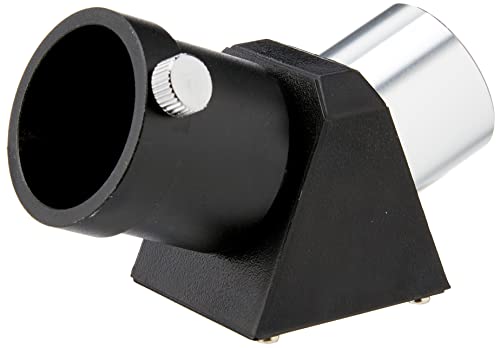This site contains affiliate links to products. I may receive a commission for purchases made through these links.
Telescopes work using the following principle:
- They gather light
- They focus that light
- And then, they magnify it to make an image
However, the different kinds of lenses in a telescope determine all three of these steps. If you want to learn more about telescope lenses, this article is for you.
We will tell you what each lens does and how to choose the right one for you.
Let’s dive in.
Types of telescope lenses
Depending on your needs, you can get many different types of simple lenses for your telescopes. They all focus the light rays in different ways. This helps us see our solar system in the particular way we want to view it.
Let’s talk more about some of these lenses.
Objective Lens
The objective lens is the most important part of a telescope’s optical system. It is responsible for gathering light from distant objects and forming an image.
The size of the objective lens is called the aperture. It’s measured in millimeters or inches. A telescope with a larger aperture will be able to gather more light. This allows it to produce a brighter image with more detail. Therefore, telescopes with large apertures are used to view the night sky.
The type of telescope will determine the objective lens. A reflecting telescope uses a concave mirror as the objective lens. On the other hand, refracting telescopes use a convex lens.
The aperture and quality of the objective lens determine the telescope’s resolving power. This is the ability to distinguish small details in an image.
Additionally, the aperture and quality of the objective lens determine the telescope’s light-gathering ability. This is the ability to collect light from faint objects.
A larger aperture and a higher-quality objective lens will result in a higher resolving power and greater light-gathering ability.
If you are starting, you might need to learn how telescopes work. The Celestron 70mm Travel Scope is a great budget telescope you can buy to help you get started with photographing astronomical objects.
Eyepiece Lens
The eyepiece lens is the lens located at the eyepiece end of a telescope. It’s the end from where you look. This lens is also called the ocular.
The eyepiece works in conjunction with the objective lens. Its role is to gather light rays coming from the objective lens. The eyepiece lens further magnifies these incoming light rays.
The eyepiece lens is typically smaller than the objective lens. It is made from high-quality glass, which helps to focus light. This produces a sharp, clear image of the distant object.
The eyepiece lens and the objective lens determine the telescope’s magnification. The objective lens’s focal length divided by the eyepiece lens’s focal length gives us magnification.
A lower focal length eyepiece lens will result in higher magnification. Conversely, a higher focal length eyepiece lens will result in a lower magnification.
The eyepiece lens also affects the telescope’s field of view (FOV). Field of view is the angular size of the area of sky visible through the telescope. A smaller eyepiece lens will result in a narrower FOV. On the other hand, a larger eyepiece lens will result in a wider FOV.
If you want to look at planets, you might be interested in learning more about the Best Telescope Eyepieces for Viewing Planets.
Barlow Lens
A Barlow lens is used between the eyepiece and the objective lens of a telescope. It increases the magnification of the telescope without having to change the eyepiece.
A Barlow lens works by effectively increasing the focal length of the telescope’s objective lens. This, in turn, increases the magnification.
The amount of magnification provided by a Barlow lens is typically indicated by a “power” number. It’s usually 2x or 3x.
This number represents the factor by which the telescope’s magnification is increased when the Barlow lens is used. For example, a 2x Barlow lens will double the telescope’s magnification.
A Barlow lens also has some downsides. It increases the effective focal length of the telescope. This can cause the image to become dimmer. It also increases vignetting (darkening at the edges of the image) and reduces the field of view.
If you want Barlow lenses, you can find decent ones for around $40. Here’s a great 2x Barlow lens that is very popular on Amazon:
Field Lens
The field lens is a lens located within the eyepiece of a telescope. It is typically the first lens that the light from the objective lens encounters as it enters the eyepiece.
The field lens collates the light from the objective lens before reaching the eye lens.
The field lens is positioned close to the objective lens. It spreads out the light coming from the objective all over the eyepiece. This helps the image formation and results in a sharper, more evenly illuminated image.
The field lens also helps correct the distortion in the image formed by the objective lens.
Field lenses are typically made from high-quality glass, and their design is critical to the overall performance of the eyepiece.
Focuser Lens
The focuser lens in a telescope is a mechanism that allows you to adjust the focus of the telescope.
The focuser lens typically consists of two main components: the focus knob and the focuser tube.
The focus knob makes small adjustments to the telescope’s focus. The focuser tube is the part of the focuser lens that holds the eyepiece. And it also connects the eyepiece to the telescope’s optical tube.
The focuser lens adjusts the distance between the eyepiece and the objective lens. This is achieved by moving the eyepiece or the objective lens along the focuser tube. It helps in adjusting the sharpness of the image.
The focus knob is used to make these adjustments. It typically has markings or a scale to indicate the position of the focuser lens.
Diagonal Prism Lens
A diagonal prism lens is an optical device used in telescopes to change the direction of the incoming light by 90 degrees. This helps in moving the eyepiece to a more comfortable viewing angle.
It is typically used in a refractor telescope. Refracting telescopes work with an eyepiece at a 90-degree angle to the main optical tube.
Diagonal prism lenses are typically made from high-quality glass or prism materials. They can be made in different shapes. For example, they can come in a 45-degree angle or a 90-degree angle.
The most common diagonal prism lens is the 90-degree diagonal prism lens. It provides the most comfortable viewing angle for most observers. You can buy them for about $50 on Amazon.
If you are interested, here’s a great pick for a diagonal lens:
You may also like: Refractor vs Reflector Telescope: What Is The Difference?
Corrector Lens
A corrector lens is also known as a field flattener or flattener lens. It’s used to correct distortion and aberrations in the image. Usually, distortions are caused by the curvature of the primary mirror or lens.
It is typically used in a reflecting telescope. It’s placed at the telescope’s focal plane, between the primary lens and the focuser lens.
The corrector lens works by compensating for the spherical shape of the objective lens. This can cause distortion and aberration in the image.
The corrector lens rectifies it by flattening the field of view. This allows for a sharper, more accurate image across the entire field.
Corrector lenses are typically made from high-quality glass. They can be designed to work with specific telescope designs or focal ratios. They can be placed in different positions, depending on the telescope design.
Coma Corrector Lens
A coma corrector lens is used in telescopes to correct for a specific type of distortion called a coma. Coma is an aberration that causes stars to appear elongated and distorted. It particularly occurs at the edges of the field of view.
The curvature of the objective in fast f/4 and faster telescopes typically cause it.
The coma corrector lens is placed in the optical train of the telescope. It is typically between the focuser and the eyepiece.
It works by compensating for the curvature of the objective. It is designed to correct the coma aberration by bending the incoming light so that the image appears sharp. This makes the image focused across the entire field of view.
Zoom Lens
A zoom lens is a type of lens that allows the focal length to be varied. This allows the user to change the image’s magnification and field of view without changing lenses.
Typically, a zoom lens is one of the different eyepieces you can use in a telescope. This can be useful for observing objects at different magnifications. It also allows for fine-tuning the focus of an image.
Zoom lenses move one or more groups of lens elements inside the barrel. This changes the distance between the lens elements and the focal plane. As a result, the magnification of the image changes.
Zoom lenses can be found in various telescope designs, including reflecting telescopes.
The quality of the image of a zoom lens can vary based on a few factors. It depends on the quality of the lens elements and the design of the lens. Higher-quality zoom lenses typically have better image quality and less distortion than lower-quality zoom lenses.
How telescope lenses work
The objective lens is responsible for gathering light. The focusing mechanism is responsible for focusing the light. The eyepiece is responsible for magnifying the image.
By adjusting these three components, the user can control:
- The amount of light that enters the telescope
- The focus of the image
- The magnification of the image.
Gathering light
The objective lens, also known as the primary lens, is the main lens in a telescope. It is responsible for gathering light.
This is one of the big lenses. It is typically larger in diameter than the other lenses in the telescope.
It is located at the front of the telescope. The objective lens is designed to collect as much light as possible. This is important for viewing faint objects in the night sky.
The light passes through the objective into the long tube of the telescope. That’s where other lenses focus on it to create an image.
Focusing light
Once the objective lens gathers the light, it is then focused by the telescope’s focusing mechanism. This mechanism typically consists of a focusing knob or a rack-and-pinion system.
The knob adjusts the distance between the objective lens and the eyepiece. By adjusting this distance, the user can fine-tune the focus of the image, making it sharper and clearer.
Magnification
The eyepiece at the back of the telescope magnifies the image.
The eyepiece contains one or more lenses that are used to increase the apparent size of the image.
Learn more about: How to Increase the magnification of a telescope in this article.
How to choose the right telescope lens
When choosing a telescope lens, consider the aperture size, focal length, and quality of lens coatings.
The aperture size determines how much light the lens can gather. The focal length determines the magnification of the image. And the quality of the lens coatings determines how bright and sharp the image will be.
The ideal lens depends on what you want to observe and your budget.
Aperture size
The aperture size is the diameter of the objective lens and is measured in millimeters. The larger the aperture, the more light the lens can gather.
A larger aperture allows you to see fainter objects. It also increases the resolution of the image.
However, larger aperture lenses are also typically more expensive and heavier.
Suppose you’re interested in viewing deep-sky objects such as galaxies and nebulae. In that case, you’ll want to choose a telescope with a larger aperture. A smaller aperture will suffice if you’re interested in viewing planets and the Moon.
Are you still trying to figure out what is a good aperture for a telescope? You can find out more about it on the link.
Focal length
The focal length is the distance between the objective lens and the point where the image is formed. It is measured in millimeters. The longer the focal length, the higher the magnification.
But long focal lengths also decrease the field of view. A shorter focal length provides a wider field of view but a lower magnification.
The ideal focal length depends on what you plan to observe. For example, a shorter focal length for deep-sky objects is better as it provides a wide field of view. A longer focal length is ideal for planetary observations as it provides a higher magnification.
Quality of lens coatings
The quality of the lens coatings is another important factor to consider when choosing a telescope lens. The lens coatings are applied to the lens surfaces to reduce reflection and improve light transmission.
Good quality coatings will help produce bright, sharp images. Look for lenses with multi-coatings to get the best image possible.
You may also like: How to Use a Telescope (Explained for Beginners)
Takeaway – Choose the best telescope lenses for you!
In conclusion, telescope lenses are an essential component of telescopes that allow us to observe and study the wonders of the universe. These lenses are designed to gather and focus light, creating a magnified image of celestial objects that would otherwise be too dim or distant to see with the naked eye.
By carefully selecting the shape and material of the lens, astronomers can optimize the performance of their telescopes for specific applications, such as viewing the moon, stars, galaxies, or planets.
Understanding how telescope lenses work is a fundamental part of astronomy and can inspire a lifelong fascination with the mysteries of the cosmos. As technology advances, we can look forward to even more exciting discoveries and insights about the universe thanks to telescope lenses’ continued innovation and improvement.
Clear skies!
Read also:








